 The Journal of the American Medical Association (JAMA) found that after heart disease and cancer, the third leading cause of death in America was caused by medical negligence. Despite those figures, medical malpractice cases can often be the most contentious type of negligence case victims may file – that is to say they are boldly asserting that the physician and/or medical provider failed to satisfy the requisite standard of care. Often times, health care providers are revered and held to the highest regard in the community, which makes it more difficult to prove to the opposing side, judge, or jury. According to a 2006 New England Journal of Medicine study, 21% plaintiffs won at trial (out of the 1452 cases studied) that made it to trial whereas 61% of these claims settled out of court.
The Journal of the American Medical Association (JAMA) found that after heart disease and cancer, the third leading cause of death in America was caused by medical negligence. Despite those figures, medical malpractice cases can often be the most contentious type of negligence case victims may file – that is to say they are boldly asserting that the physician and/or medical provider failed to satisfy the requisite standard of care. Often times, health care providers are revered and held to the highest regard in the community, which makes it more difficult to prove to the opposing side, judge, or jury. According to a 2006 New England Journal of Medicine study, 21% plaintiffs won at trial (out of the 1452 cases studied) that made it to trial whereas 61% of these claims settled out of court.
Here are our most frequently asked questions regarding how to overcome and maneuver challenges that plaintiff patients may face when bringing a medical malpractice claim:
1. What kind of proof does a medical malpractice case require?
Medical negligence cases require proof that the physician and/or medical provider’s failure to exercise due care was the proximate cause of injuries to the patient. In other words was the harm caused by the negligence or natural progression of the particular disease or ailment suffered by the patient.
2. Who does the victim bring a claim against?
Traditionally, it was easy to go after the physician, but in modern times, patients consult with various doctors, get treated at large facilities, and have to go through their insurance companies, HMO, or MCO.
3. How would the medical malpractice lawyers present my case to a jury?
Since the medical malpractice lawyers need to lay the groundwork by addressing what was actually done to the patient, in comparison to what should have been done in this situation, they often employ medical experts to explain these highly technical questions. Patients can testify to how they feel regarding their injuries, whereas an expert witness can explain the following: what the requisite standard of care was for the particular procedure or treatment, whether the medical provider deviated from this requisite standard of care; whether the deviation from the requisite standard of care resulted in the injuries; and the amount of the monetary compensation owed to the victim due to this deviation from the requisite standard of care.
4. What are some other malpractice defenses that might be employed
against the victim?
The defense may try to argue that the case was not timely filed, as there is a specific time frame to bring a medical malpractice case. Often times, the defense may try to argue: that the health care provider was not negligent; that the patient assumed the risk by signing the consent forms before the medical treatment offered to the patient; or that the patient contributed to his or her own negligence by not providing complete accurate medical history, which could possibly reduce or eliminate any recovery.
Lundy Law: Assisting Victims Involved in Medical Malpractice Cases
Medical providers are frequently making negligent mistakes in outpatient and inpatient settings. Some of these mistakes can lead to serious injuries even fatalities. Why should you or a loved one suffer from medical provider negligence? Please contact our firm immediately at 1(800) LUNDYLAW® whether you might have a viable negligence cause of action against a medical provider that may have botched up a surgery, medical procedure or treatment. Our team of highly skilled trial lawyers can immediately assess your claims before it is too late to bring a case.















